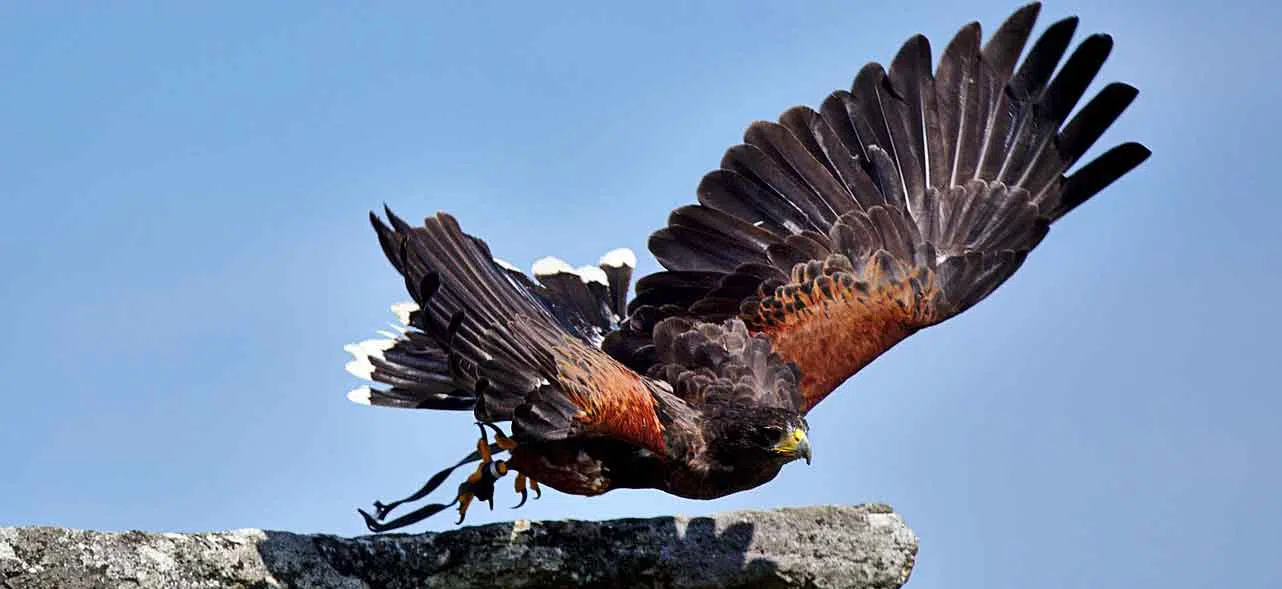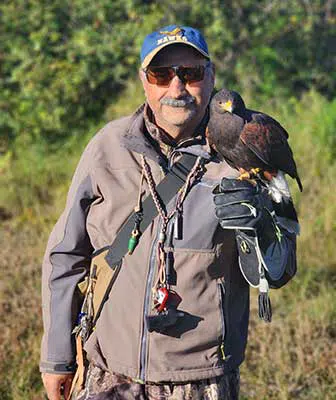- Birds of Prey, or raptors, are natural predators to many pest birds.
- Raptors disrupt breeding and roosting of pest birds.
- Raptors create stress in pest birds.
- Falconry is highly targeted to particular species of pest birds.
- Falconry is ecologically and environmentally friendly.
- Falconry is regulated and overseen by government agencies in many countries to ensure it is conducted ethically and professionally.

What is Falconry?
Falconry is the ancient art of hunting with trained birds of prey. It has been practiced for thousands of years in many cultures around the world. More recently, falconry is used for bird control, wildlife removal and abatement, It takes advantage of the natural relationship between bird predators and their prey. The predators - birds of prey, or raptors, are trained to scare away and chase pest birds. With a raptor in the area, the pest birds quickly learn the area is no longer safe. The pest birds become stressed and they quickly learn to avoid the area entirely.
 How does Falconry work with Bird Control?
How does Falconry work with Bird Control?
Birds of prey, or raptors, include eagles, hawks, falcons, owls and vultures. They are natural predators for many species of pest birds. Pest birds include - but are not limited to - starlings, pigeons, seagulls, swallows, cormorants, geese, grackles, doves. The list is long. Many pest birds are protected by the Migratory Bird Act of 1918 and require a permit from the government to remove nests and eggs, or otherwise deter the pest bird population. Having a raptor in the area creates an environment of danger and fear for the birds. Once they learn this area is dangerous for them they leave. The sight of a raptor flying over them is enough to trigger an immediate fear response in the pest birds. Some pest birds, such as crows, will gang up and try to intimidate the raptor and get them to leave. This seldom works as trained birds of prey are quite forceful and dynamic which enhances their effectiveness in bird control. The continuous presence of birds of prey will stress any pest birds in the area, leading them to relocate entirely to a new area. Stress can change bird behaviour, feeding, and breeding. It may take years before the pest birds will return to that area and only if there are no more predators around.
What are the Advantages of Falconry?
Using falconry for bird control is natural and humane. No poisons or chemicals or mechanical methods that will interfere with Mother Nature. Traps of any kind can affect other wildlife in the area and poisons or chemicals can affect much more than the intended target. The goal of falconry is to deter pest birds, not to kill.
There are regulatory and training standards for falconry in most countries around the world. Permits are issued by governmental agencies to ensure falconers have undergone the training which includes ethics and professionalism in hunting and flying birds of prey, as well as caring for birds of prey. These standards and regulations ensure the raptors are well treated and their use in bird control is ethical and humane.
Where is Falconry typically used for Bird Control?
Falconry for use in bird control is preferred in agriculture, especially when the seeds are just planted and starting to sprout. Pest birds can cause extensive damage in grain fields, vineyards, flowers fields. This more natural method decreases the need for chemicals and poisons and helps promote more sustainable farming practices.
Airports are a classic example of the use of falconry to deter pest birds. Traditional methods - ie: a man with a shotgun at the end of a runway - usually fall short of what is necessary for safety. Bird strikes on air craft is a significant safety risk to planes and passengers. A well known example of this is “Miracle On The Hudson” where a flock of geese took out the engines of an Airbus A320 and it was landed in the middle os the Hudson River shortly after takeoff. Having a trained eagle flying at height would have deterred the geese from flying in the area.
Warehouses, large industrial bakeries, even in urban areas, pest birds can become a problem and cause extensive property damage. When gulls nest on a warehouse rooftop the feces can rot through a roof. Feathers of any bird can carry disease and when nests are up against HVAC systems, the feathers can end up in these systems and disease can be blown inside the building for people to inhale and possibly become ill themselves. Any food warehouse can be shut down by public health if there are birds found inside the buildings.
Why Hawkeye uses Falconry
Falconry is an efficient and reliable method of bird control because of the natural relationship between predator and prey. This includes the psychological impact on pest birds and the natural stress of predation and displacement caused by the very presence of the predator. This is a very powerful and compelling deterrent. Falconry is environmentally friendly, ethical and adaptable to almost any setting. Using falconry for bird control is faster and lasts longer than most other comparable methods that use "scare" tactics, including noise makers, or shooting and trapping. Falconry for bird control is achievable, sustainable, and very effective, while respecting the balance and symmetry of Mother Nature.
Hawkeye Bird Control
At Hawkeye, we've been doing bird control using falconry for over 30 years. We have several falconers on staff, and of course, Master Falconer Dan Frankian himself. Give us a call to discuss your bird control needs!














